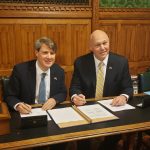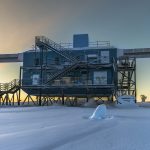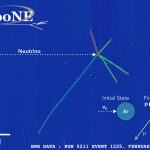From Cambridge Network, Feb. 3, 2020: Representatives from UK Research and Innovation and the US Department of Energy have signed an agreement that outlines £65 million worth of contributions that UK research institutions and scientists will make to the international Deep Underground Neutrino Experiment and related projects hosted by Fermilab. DUNE will study the properties of mysterious particles called neutrinos, which could help explain more about how the universe works and why matter exists at all.
neutrino
From UKRI, Jan. 23, 2020: Representatives from UK Research and Innovation and the U.S. Department of Energy have signed an agreement that outlines £65 million worth of contributions that UK research institutions and scientists will make to the international Deep Underground Neutrino Experiment and related projects hosted by Fermilab. DUNE will study the properties of mysterious particles called neutrinos, which could help explain more about how the universe works and why matter exists at all.
From STFC, Jan. 23, 2020: Representatives from UK Research and Innovation and the U.S. Department of Energy have signed an agreement that outlines £65 million worth of contributions that UK research institutions and scientists will make to the international Deep Underground Neutrino Experiment and related projects hosted by Fermilab. DUNE will study the properties of mysterious particles called neutrinos, which could help explain more about how the universe works and why matter exists at all.
Representatives from UK Research and Innovation and the U.S. Department of Energy signed an agreement that outlines £65 million worth of contributions that UK research institutions and scientists will make to the international Deep Underground Neutrino Experiment and related projects hosted by Fermilab.
From PBS Space Time, Jan. 6, 2020: Why is there something rather than nothing? The answer may be found in the weakest particle in the universe: the neutrino. In this 10-minute video, PBS Space Time host Matt O’Dowd and Fermilab scientist Don Lincoln explore the mysteries of the neutrino and how Fermilab is tackling them. The elusive neutrino may hold powerful secrets, from the unification of the forces of nature to the biggest question of all: Why is there something rather than nothing?
Underneath the vast, frozen landscape of the South Pole lies IceCube, a gigantic observatory dedicated to finding ghostly subatomic particles called neutrinos. Neutrinos stream through Earth from all directions, but they are lightweight, abundant and hardly interact with their surroundings. A forthcoming upgrade to the IceCube detector will provide deeper insights into the elusive particles.
From Black Hills Pioneer, Dec. 13, 2019: Scientists at Fermilab and the Sanford Underground Research Facility in South Dakota are eager to begin collecting data from the Long-Baseline Neutrino Facility and the international Deep Underground Neutrino Experiment, which is hosted by Fermilab. But before the world’s largest neutrino experiment can begin producing results, more than 800,000 tons of rock will need to be removed from the 4,850-foot level of a former mine to make room for the detectors.
From FAPESP, Dec. 20, 2019: Os físicos Ana Amélia Bergamini Machado e Ettore Segreto foram os ganhadores do DPF Instrumentation Early Career Award de 2019.
Scientists on Fermilab’s MicroBooNE experiment have measured neutrino interactions on argon with unprecedented statistics and precision using data on the resultant muons — in particular, the muon’s momentum and angle. The experiment features the first liquid-argon time projection chamber with the resolution and statistics to carry out such a measurement. Researchers will use the result to improve simulations of neutrino interactions. These improvements are important for neutrino experiments in general, including the Short-Baseline Neutrino program experiments and the international Deep Underground Neutrino Experiment, both hosted by Fermilab.
From Forbes, Dec. 6, 2019: Fermilab scientist Don Lincoln gives a primer on neutrinos, neutrino oscillation and how studying neutrinos can help scientists explain the observed dominance of matter in the universe. And they’re doing just that with two Fermilab experiments, NOvA and DUNE.



